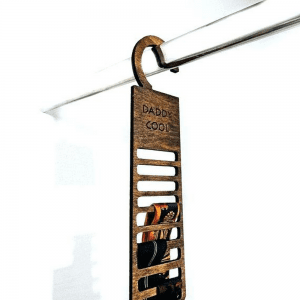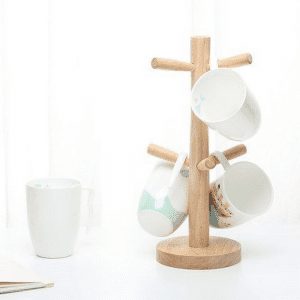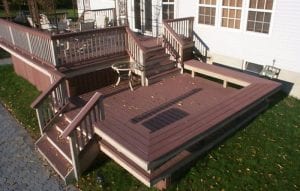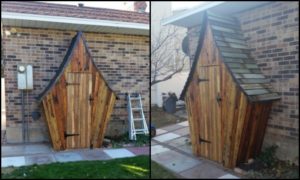Last Updated on December 3, 2024 by teamobn
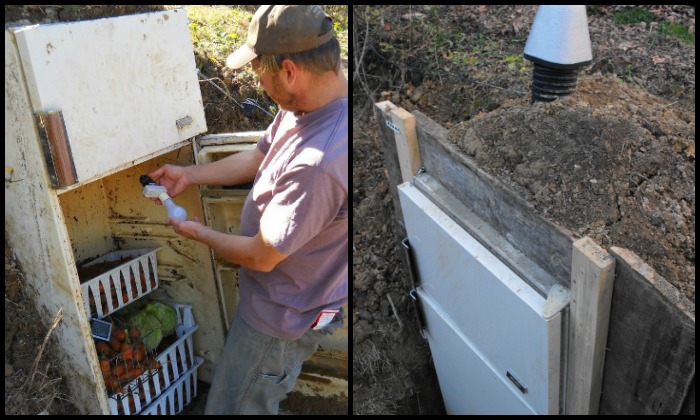
Storing your harvest is a good way to manage surplus of produce and months when little is growing. There are many ways to store your vegetables, but the right space and storage can sometimes be a problem.
If you find yourself with an abundance of root vegetables like potatoes and carrots, or fruits like apples, don’t let them go to waste. Build a root cellar for storage, instead.
A root cellar is a type of storage facility that farmers and gardening enthusiasts use to store vegetables, fruits, and other perishable produce. The natural environment controls the temperature and humidity in a root cellar. A ground fridge helps to keep the food inside fresh for extended periods.
You can turn an old refrigerator into an effective storage solution for your produce. If you don’t have access to an old fridge, you can also repurpose a chest freezer – just be sure to keep it in a cool, dark place. With a little effort, you can enjoy your homegrown produce all year round!
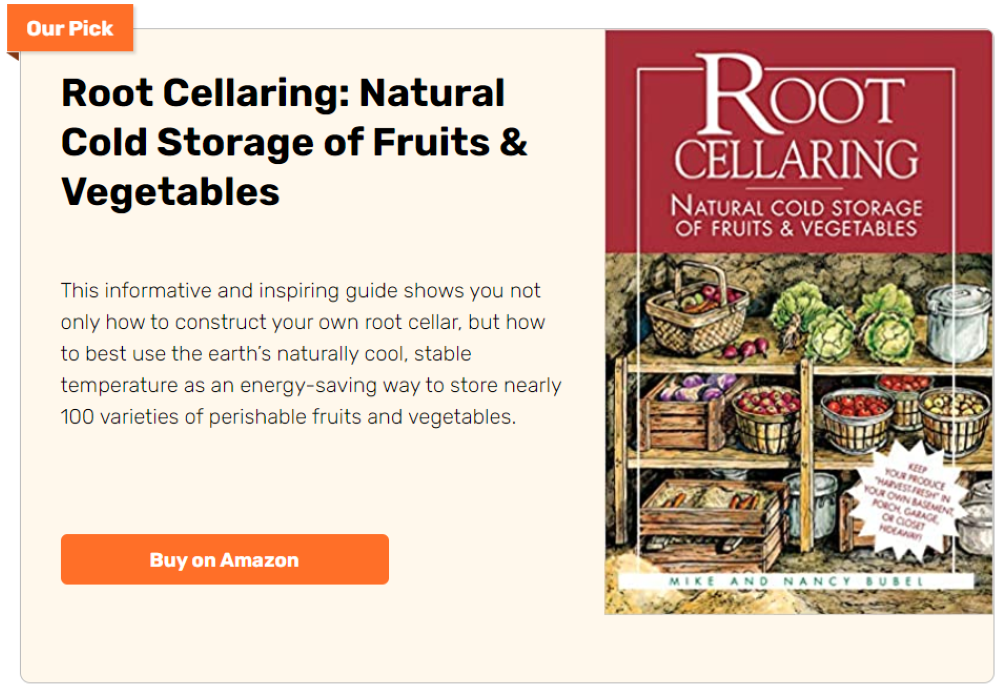
Farmers in Europe and North America have been using root cellars to keep their harvests from freezing during the winter and cool during the summer for hundreds of years. The earliest root cellars were built underground.
While they are called root cellars because people used them to store root crops, the farmers and homesteaders of the 17th and 18th century also used them to keep fruits and other vegetables fresh.
Root cellars are one of the oldest food storage methods still in use today. Many modern farmers, homesteaders, and gardening enthusiasts still use root cellars to store their harvests, along with modern appliances that store food like refrigerators and freezers. Root cellars are the preferred post-harvest system of people who value self-sufficiency, as well.
These simple storage systems can also be used to store food purchased from a grocery store or farmers’ market. Either way, a root cellar is a smart way to keep food fresh.
These days, you can build one with earthbags, concrete blocks, or timber. If you live in an area with a cold climate, a root cellar can still help you keep your food from freezing.
There are a few things to consider when you’re deciding how to build your root cellar. The first is what material you want to use. Earthbags are a popular choice because they’re easy to work with and they’re environmentally friendly. Concrete blocks are another popular choice because they’re durable and they won’t rot or decay like timber.
Of course, building a root cellar into the ground will require plans for an extensive construction project and considerable space in your yard. For a job like that, we suggest that you consult with a professional contractor to get an estimate of the costs and timeline involved.
If you’re looking for a simpler, easier, more cost-effective option, you can recycle an old refrigerator or chest freezer. This is perfect for gardeners who tend relatively smaller gardens but produce an abundance of produce. Root cellars are likewise an excellent way to reduce your carbon footprint and help the environment!
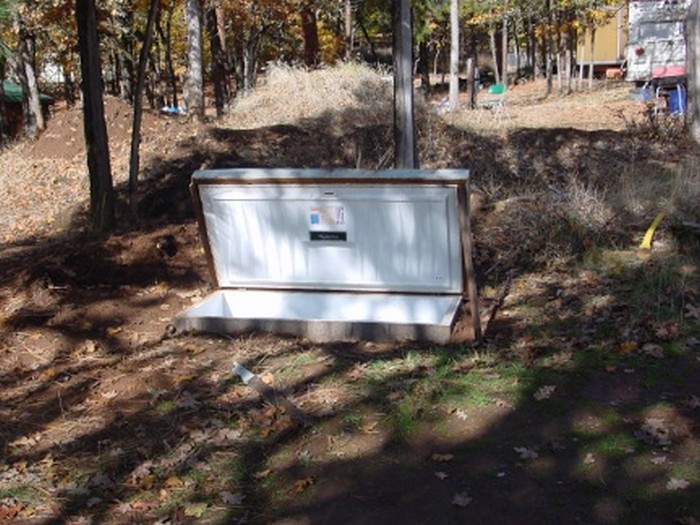
Do you need this in your yard? View our album to see more of this idea and head over to a step-by-step guide from The Walden Effect through the link below!
Note: Please be mindful of refrigerator safety protocols. Never use a fridge or freezer that can’t be opened from the inside.
Contents [show]
How to Build a Root Cellar Refrigerator
What you’ll need to build your root cellar…
- Old Refrigerator (or Chest Freezer)
- Plastic Food Baskets
- 2×4 Timber
- Scrap Wood
- 4 Cinder Blocks
- Foam Faucet Cover
- PVC Pipe
- Screen (for keeping bugs out)
- Screws and Nails
And these tools:
- Shovel
- Jigsaw
- Drill
- Hammer
- Post Hole Digger
Click on any image to start the lightbox display. Use your Esc key to close the lightbox.![]()
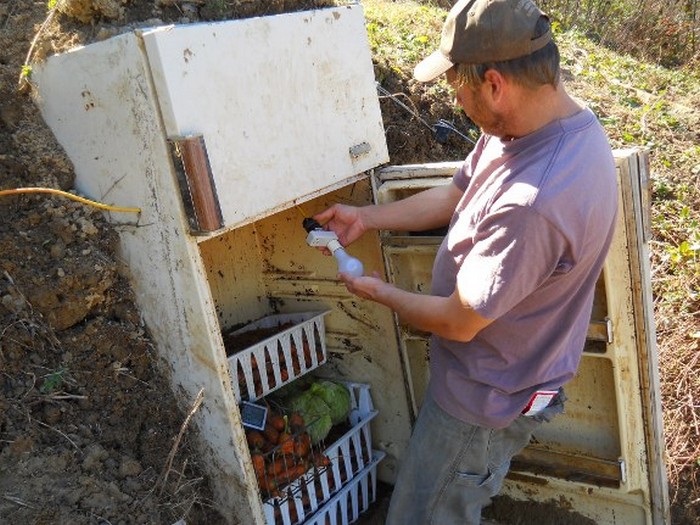
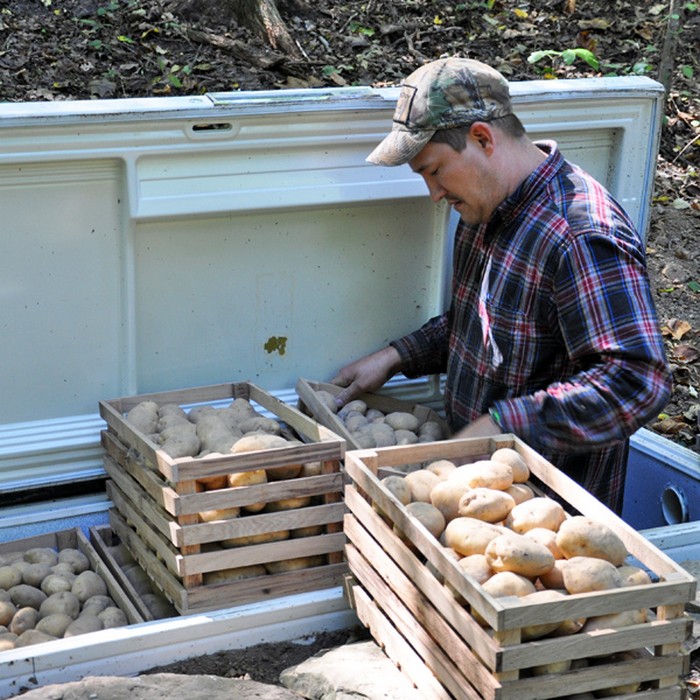
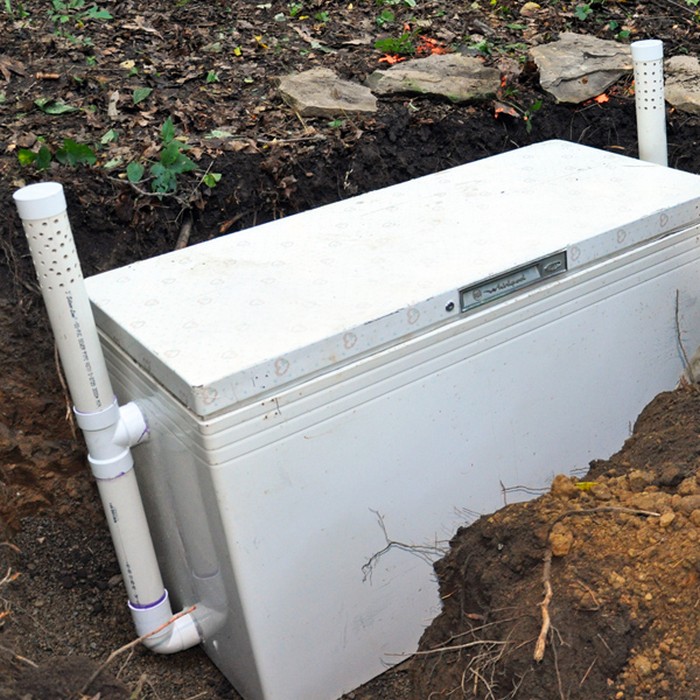
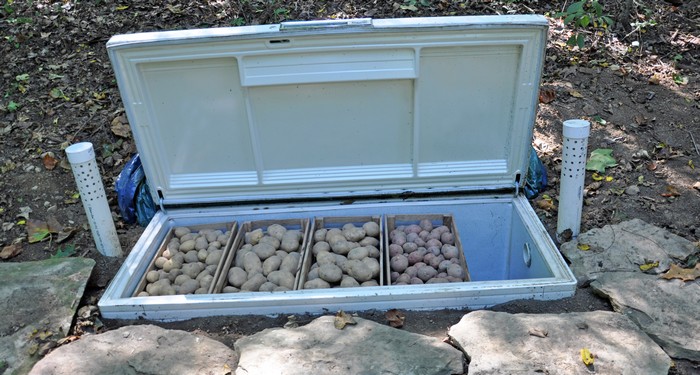
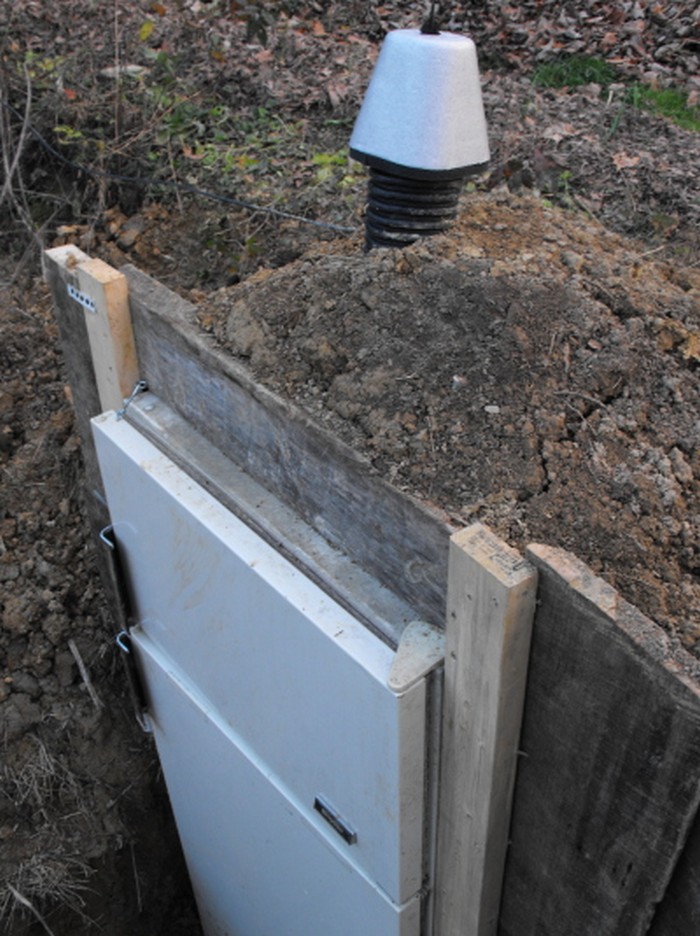

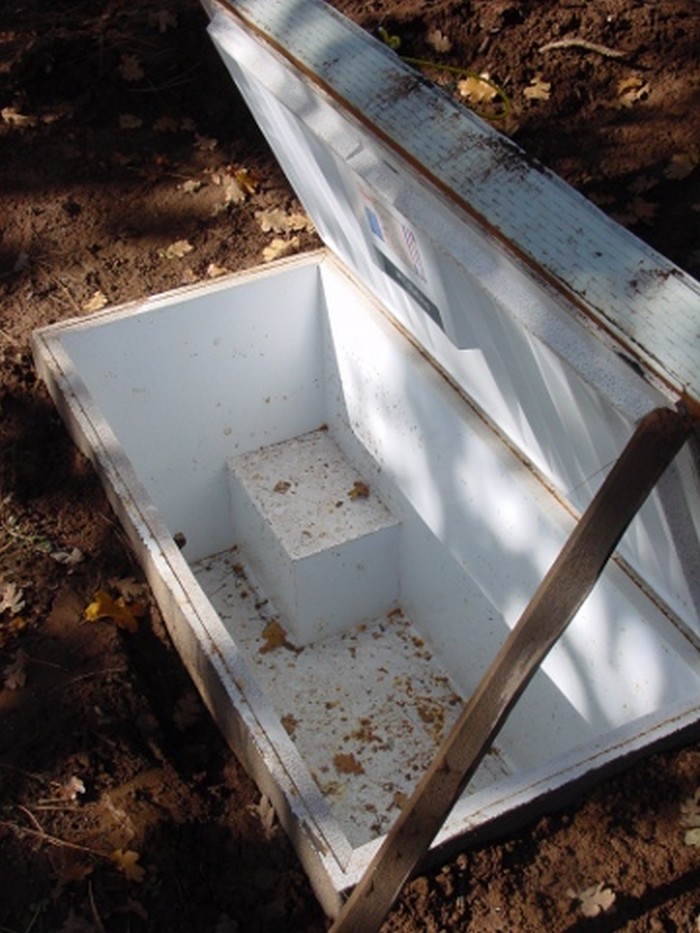


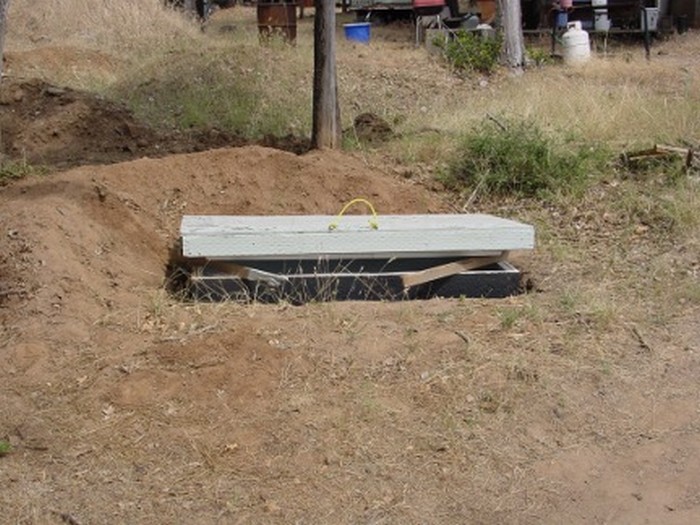
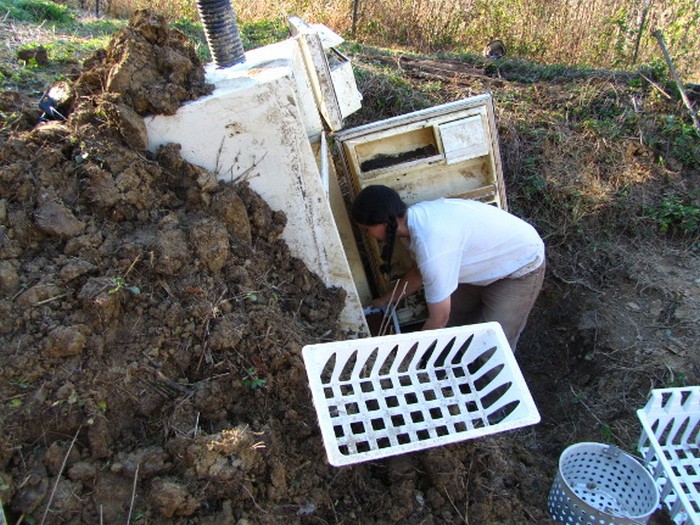
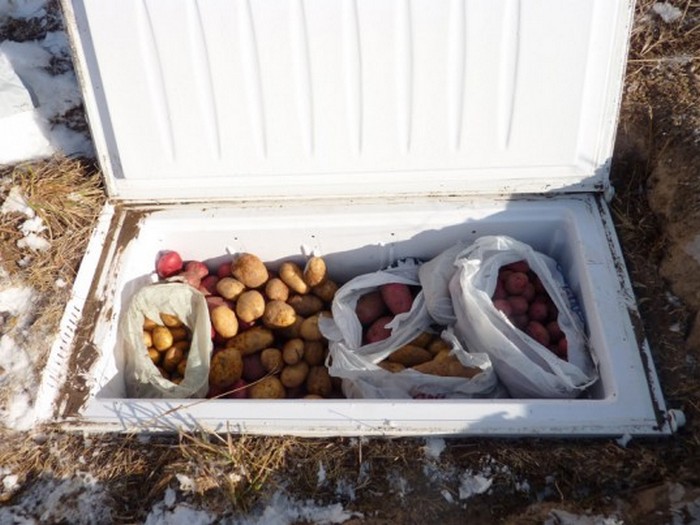
Building an inexpensive root cellar using an old refrigerator is a practical and straightforward way to preserve your produce and extend its shelf life. With just a few simple steps, you can transform an unused appliance into a functional cold storage solution that will keep your fruits, vegetables, and other perishables fresh for months.
Are you ready to walk through the process of building your root cellar using an old refrigerator?
1. Prepare the Refrigerator:
- Clean the old refrigerator thoroughly, removing any remnants of food or odours.
- Remove shelves, drawers, and unnecessary components to maximize storage space.
2. Build the Timber Frame:
- Construct a frame using 2×4 timber, ensuring it is large enough to accommodate the refrigerator.
- Reinforce the frame with scrap wood at critical points to enhance stability.
3. Position the Cinder Blocks:
- Place the four cinder blocks in a square formation, creating a stable foundation for the root cellar.
- Ensure the blocks are level and evenly support the timber frame.
4. Install the Refrigerator:
- Set the cleaned and emptied refrigerator onto the timber frame.
- Confirm that the refrigerator sits securely and evenly on the frame.
5. Insulate Exposed Coils:
- Wrap the exposed coils of the refrigerator with a foam faucet cover to prevent condensation and maintain the desired temperature.
5. Make the Ventilation System:
- Cut PVC pipes to the desired length and position them to allow air circulation.
- Ensure the pipes are securely attached to the refrigerator, providing an effective ventilation system.
6. Add Screen Protection:
- Attach screen material over openings, such as the ventilation system, to prevent insects from entering while allowing proper airflow.
7. Organize with Plastic Baskets:
- Place plastic food baskets inside the refrigerator to organize and separate different types of produce.
By repurposing an old refrigerator into a root cellar, you not only contribute to sustainable living but also create a valuable storage solution for your perishables. This DIY project offers an affordable and eco-friendly alternative to conventional root cellars, allowing you to extend the shelf life of your fruits and vegetables. Embrace the satisfaction of building your root cellar while minimizing waste and maximizing the use of available materials.
Thank you The Walden Effect for the invaluable strategies on how to make a root cellar with an old refrigerator.
The Advantages of Building an Inexpensive Root Cellar Using an Old Refrigerator
Creating a root cellar using an old refrigerator presents a practical and cost-effective solution for preserving fruits, vegetables, and other perishables. This DIY approach not only repurposes an existing appliance but also provides numerous advantages over traditional root cellar construction.
1. Cost-Effectiveness
Building a root cellar from scratch can be a significant investment in both time and money. By repurposing an old refrigerator, you can achieve similar benefits at a fraction of the cost. The primary expense is likely to be the minimal materials required for insulation and ventilation, making this an economical option for homeowners on a budget.
2. Accessibility
Unlike traditional root cellars, which may require excavation or significant structural modifications to your home, repurposing an old refrigerator offers a more accessible solution. Most households already have an unused refrigerator or chest freezer that can be repurposed with minimal effort. This accessibility reduces the barriers to creating a root cellar, making it a viable option for a wide range of homeowners.
3. Space Optimization
Modern refrigerators are designed to maximize storage space efficiently. By converting an old refrigerator into a root cellar, you can take advantage of its existing shelving and compartmentalization features to organize and store a variety of produce.
Additionally, stacking plastic food baskets further optimizes space utilization, allowing you to store more items in a compact area.
4. Customization
Repurposing an old refrigerator allows for a high degree of customization to suit your specific needs and preferences. You can adjust the size and layout of the root cellar to accommodate the available space in your home and the quantity of produce you wish to store.
Furthermore, you can tailor the ventilation system and insulation to ensure optimal conditions for preserving your perishables.
5. Energy Efficiency
Modern refrigerators are designed to operate efficiently, making them inherently energy-efficient storage solutions. By converting an old refrigerator into a root cellar, you can take advantage of its insulation and temperature control features to create a stable environment for storing produce.
With proper insulation and ventilation, the root cellar can maintain the desired temperature without consuming excess energy.
6. Environmental Sustainability
Repurposing an old refrigerator aligns with principles of environmental sustainability by extending the lifespan of the appliance and reducing waste. Rather than disposing of the refrigerator or chest freezer, which can contribute to landfill waste and environmental pollution, repurposing it as a root cellar gives it a new purpose and prolongs its utility.
Additionally, using minimal materials for insulation and ventilation minimizes the environmental impact of construction.
7. Long-Term Preservation
A properly constructed root cellar provides an ideal environment for long-term preservation of fruits, vegetables, and other perishables. The consistent temperature, high humidity, and adequate ventilation help slow the ripening and decay process, allowing you to enjoy fresh produce for an extended period.
With regular maintenance and monitoring, your repurposed root cellar can serve as a reliable storage solution year-round.
Building an inexpensive root cellar using an old refrigerator offers numerous advantages, including cost-effectiveness, accessibility, space optimization, customization, energy efficiency, environmental sustainability, and long-term preservation.
By following seven straightforward steps, homeowners can repurpose an existing appliance to create a functional storage solution for preserving fruits, vegetables, and other perishables. Embrace the practicality and benefits of transforming an old refrigerator into a root cellar to enjoy fresh produce year-round while minimizing waste and maximizing resource efficiency.
Safety Precautions for Root Cellar From Old Refrigerators
When repurposing an old refrigerator to create a root cellar, safety precautions are paramount to ensure the project is completed safely. Here are some key safety measures to consider:
1. Proper Ventilation: Ensure adequate ventilation in the area where the root cellar will be located to prevent the buildup of gases emitted by the refrigerator’s compressor and other components.
2. Electrical Safety: Before starting any modifications, unplug the refrigerator from the power source and ensure it is completely disconnected to avoid the risk of electric shock.
3. Handling Refrigerants: If you’ll be modifying the refrigerator’s cooling system, it’s crucial to handle refrigerants properly. Consult a professional or follow guidelines provided by your local authorities for safe handling and disposal.
3. Sharp Tools Awareness: Use caution when handling sharp tools such as saws or drills during the modification process to avoid injury. Wear appropriate safety gear, including gloves and eye protection.
4. Securing Heavy Components: When removing or installing shelves, drawers, or other heavy components, take care to avoid accidents or strain. Enlist the help of others if needed, and ensure everything is securely fastened in place.
5. Proper Insulation: Insulate the interior of the refrigerator adequately to maintain the desired temperature and humidity levels. Use insulation materials that are safe for use in enclosed spaces and follow manufacturer guidelines.
6. Regular Maintenance: Once the root cellar is operational, conduct regular inspections and maintenance to ensure continued safety and efficiency. Check for any signs of wear or damage, and address any issues promptly.
By prioritizing safety throughout the process, you can enjoy the benefits of your inexpensive root cellar with peace of mind, knowing that it has been constructed with due care and attention to safety.
Challenges of Using a Root Cellar Refrigerator
There are several challenges when it comes to storing various vegetables in your root cellar refrigerator. Below are some of the issues you will encounter:
Temperature Fluctuations
One of the significant challenges when using a refrigerator as a root cellar is managing temperature fluctuations. In colder conditions, items like potatoes, apples, and winter squash can freeze if the temperature drops too low. This can ruin produce that can’t withstand freezing, such as squash, though some items, like potatoes, may survive.
Lack of Automated Temperature Control
Without proper temperature management, even a well-planned storage system might fail. Installing a temperature-sensitive plug, which can activate a light bulb to maintain warmth, is a straightforward solution. A halogen light bulb can prevent the internal temperature from reaching freezing levels, but this solution requires some manual setup that can be overlooked.
Summer Heat Issues
During warmer months, the refrigerator might struggle to keep the interior below 55 degrees Fahrenheit. By late spring, it’s wise to remove certain vegetables to prevent spoilage, as higher temperatures can accelerate rot. This seasonal adjustment can be inconvenient if you’re relying on the fridge for year-round storage.
Energy Efficiency Concerns
Using a refrigerator as a root cellar may also raise concerns about energy efficiency. If you’re running a fridge in an uninsulated area or using a heating solution like a light bulb, it can consume more energy, impacting both environment and electricity bills.
By understanding these potential hurdles, you can better plan and adapt your refrigeration methods to maintain a consistent environment for storing produce.
The Wrap Up
Transforming an old refrigerator into a root cellar offers an economical way to store fruits, vegetables, and other perishables for extended periods. This guide outlines seven easy-to-follow steps to repurpose your unused refrigerator into an efficient root cellar, ensuring your produce remains fresh and accessible for longer durations without hefty costs.
Begin by choosing an old refrigerator that is no longer in use but still functional. Consider the available space in your designated location and ensure the refrigerator’s size accommodates your storage needs. Prioritize energy efficiency to reduce long-term operational expenses.
Thoroughly clean the interior of the refrigerator to eliminate any lingering odours or residues. If necessary, defrost the appliance completely by unplugging it and allowing it to thaw. Remove all shelves, drawers, and other removable parts to create an open space for storage.
Create adequate ventilation within the refrigerator to regulate temperature and humidity levels. Drill ventilation holes near the top and bottom of the appliance to facilitate airflow. Install vents or mesh screens to prevent pests from entering while allowing sufficient air circulation.
Maximize storage capacity by installing racks or shelves inside the refrigerator. Utilize sturdy materials such as wood or metal to construct shelves that can withstand the weight of stored produce. Customize the layout to accommodate various types of fruits and vegetables.
Improve insulation within the refrigerator to maintain stable temperatures. Consider adding insulation foam boards or styrofoam to the interior walls and door. Ensure a tight seal around the door to prevent heat exchange with the surrounding environment
Monitor and control humidity levels within the root cellar to preserve produce quality. Place a pan of water or a damp cloth inside the refrigerator to maintain adequate moisture. Regularly check and adjust humidity levels as needed to prevent dehydration or spoilage.
Regularly monitor temperature and humidity levels within the root cellar to ensure optimal storage conditions. Make any necessary adjustments to ventilation, insulation, or humidity settings based on environmental changes. Perform routine maintenance to keep the root cellar functioning efficiently.
By following these seven effortless steps, you can repurpose an old refrigerator into a cost-effective root cellar for storing your fruits, vegetables, and other perishables. With proper ventilation, insulation, and humidity management, your produce will stay fresh and accessible for extended periods without the need for expensive refrigeration units.
FAQ: Root Cellar Refrigerator
- Why should you consider building a root cellar refrigerator?
- Repurposing old furniture into a root cellar offers an eco-friendly and cost-effective way to create storage space for preserving fruits, vegetables, and other perishables. It provides a sustainable solution while utilizing existing materials.
- What types of old furniture can be converted into a root cellar?
- Various types of furniture can be repurposed, including cabinets, dressers, wardrobes, or even wooden crates. Choose furniture pieces that are sturdy, spacious, and have the potential to be sealed effectively to create an insulated environment.
- Do you need to make any modifications to the old furniture before converting it into a root cellar?
- Yes, modifications may be necessary to optimize the furniture for storing perishables. This can include sealing gaps or cracks, adding insulation materials, and installing ventilation systems to regulate temperature and humidity levels.
- How do you ensure proper ventilation in the root cellar made from old furniture?
- Install ventilation systems such as vents or holes near the top and bottom of the furniture to facilitate airflow. This helps prevent the buildup of excess moisture and maintains optimal conditions for storing produce.
- What insulation materials are suitable for lining the interior of the root cellar furniture?
- Insulation materials like foam boards, styrofoam, or reflective insulation can be used to line the interior walls of the furniture. Ensure a tight seal around the edges to minimize heat exchange and maintain consistent temperatures.
- Can you use the drawers or shelves of the old furniture for storage in the root cellar?
- Yes, the existing drawers or shelves can be utilized for storing fruits, vegetables, or other perishables. Ensure they are clean, sturdy, and appropriately lined with insulation materials to maintain optimal storage conditions.
- How do you monitor and maintain the root cellar made from old furniture?
- Regularly check temperature and humidity levels within the root cellar to ensure they remain within the optimal range. Perform routine maintenance tasks such as cleaning vents, inspecting insulation, and checking for signs of mould or pests.
- Is it safe to consume produce stored in a root cellar made from old furniture?
- Properly stored produce in a well-maintained root cellar is safe to consume. However, it’s essential to regularly inspect stored items for any signs of spoilage and discard any items that appear mouldy or rotten.
- What types of vegetables are best stored in a root cellar?
- Root cellars are versatile storage spaces that accommodate more than just traditional root vegetables. While staples like carrots, potatoes, and beets are popular, they are also ideal for hardy winter squash, fermented items like sauerkraut, and sturdy produce such as cabbage and onions. The cool, humidity-controlled environment preserves the flavor and texture of a wide variety of produce.
- Why might a refrigerator root cellar have difficulty staying below 55 degrees during the summer?
- Refrigerator root cellars often struggle to stay cool during summer due to rising ambient temperatures and limited insulation, allowing heat to seep in. Poor ventilation and the capacity limits of standard refrigerator systems designed for stable indoor conditions further challenge their efficiency in outdoor environments. Over time, insulation degradation and continuous operation under strain can reduce cooling effectiveness, making it advisable to remove sensitive items before peak summer heat.
- How can a temperature sensitive plug and a light bulb help maintain the temperature in a root cellar refrigerator?
- A temperature-sensitive plug and a light bulb offer a simple way to regulate a refrigerator root cellar’s temperature, especially in colder climates. The plug activates a halogen light bulb when temperatures drop too low, providing heat to prevent freezing, and automatically turns off when temperatures rise above the set threshold. This setup is cost-efficient, energy-saving, and requires minimal supervision, ensuring consistent storage conditions year-round.
- How should you dig a hole for the refrigerator root cellar?
- Digging a hole for a refrigerator root cellar requires planning, the right tools, and safety precautions. Start by measuring your refrigerator to determine the hole’s size and depth, ensuring it is at least 3 to 4 feet deep to stay below the frost line. Use tools like a shovel or backhoe for excavation, mark the area for precision, and check for underground utilities while wearing proper protective gear for safety.
- What are the benefits of placing a cover over the refrigerator root cellar?
- Covering your refrigerator root cellar in winter helps regulate temperature, ensuring stored goods are protected from extreme cold. It improves energy efficiency by reducing exposure to cold winds, preventing the appliance from overworking and extending its lifespan. Additionally, a cover minimizes cold drafts and frost build-up, maintaining stable storage conditions and protecting the unit.
- Why is it important to use rocks or bricks underneath the refrigerator when building a root cellar?
- Using rocks or bricks under your refrigerator in a root cellar improves airflow, aiding cooling efficiency and temperature stability for stored goods. Elevating the appliance protects it from ground moisture, preventing rust and damage, while also deterring pests from accessing stored items. A sturdy foundation ensures the refrigerator remains stable, enhancing its longevity and functionality in the damp root cellar environment.

